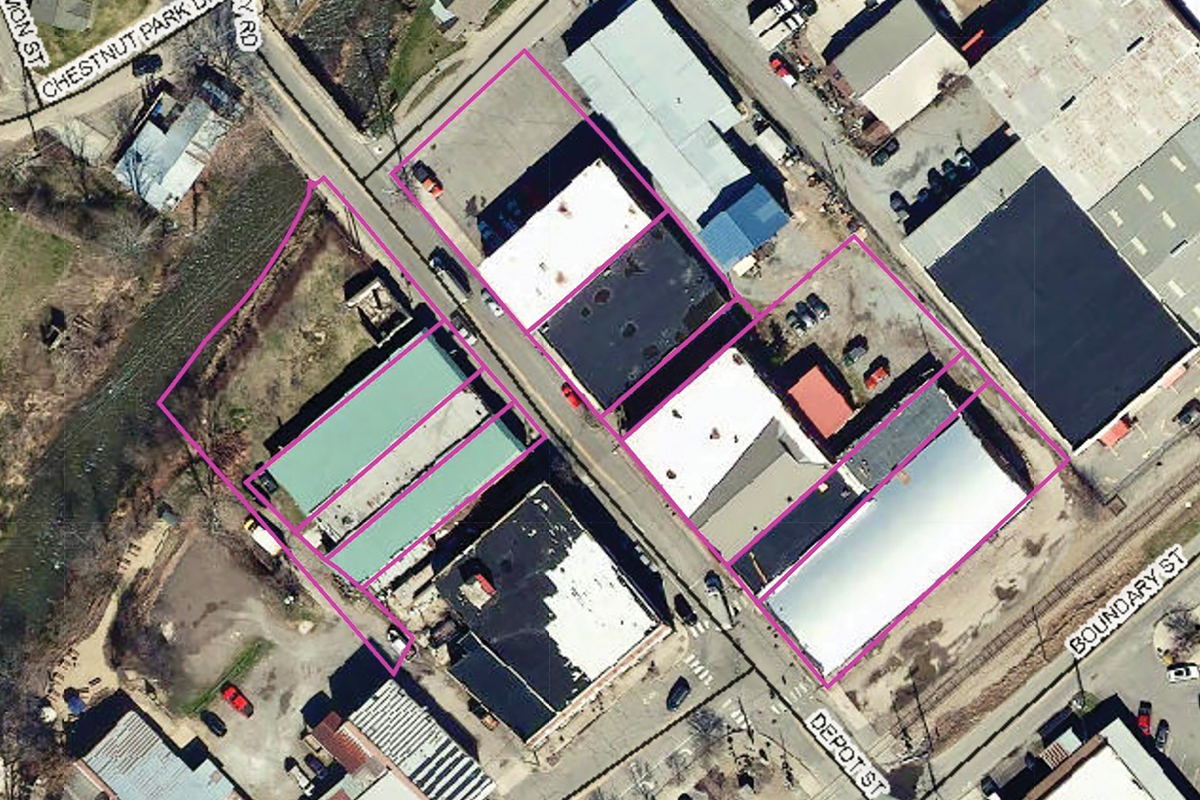Spreading it around: Waynesville pushes plans for prosperity in Frog Level, Hazelwood
 Both sides of Depot Street, from Boundary Street to Richland Creek, are home to small businesses. Haywood GIS photo
Both sides of Depot Street, from Boundary Street to Richland Creek, are home to small businesses. Haywood GIS photo
Waynesville’s North Main Street has been an important economic engine for the town and the county for decades, and the town’s municipal service district has played a significant role in that success.
Now, Town Council is exploring expansion of the district or adding new districts in other areas, but challenges with revenue, governance and participation may leave the idea in limbo.
“One thing that I would say is that the conditions at that time were pretty dire, as far as the vacancy rate on the buildings in the MSD,” said Waynesville Town Council Member Jon Feichter of the establishment of the Main Street MSD in the mid-1980s. “We owe a huge debt of gratitude to those folks that had foresight to recognize that the path that we were on was unsustainable.”
A municipal service district, enabled by state law, allows voluntary associations of property owners to self-impose an additional tax upon their properties, with the revenue supporting beautification efforts and events.
Over nearly 40 years of operation, Waynesville’s MSD has raised and spent millions on those activities.
The town used to contract with an independent nonprofit to manage the revenue derived from the tax, and to liaise with property owners, tenants and the public.
Related Items
Poor management and organization of the old Downtown Waynesville Association, which was responsible for a number of streetscape improvements from the 1980s through the early 2010s, led to the town refusing to renew the DWA’s management contract in 2021.
Instead, the contract was awarded to a new organization, the Downtown Waynesville Commission, which is not an independent nonprofit but instead an organ of the town that can avail itself of administrative assistance and guidance with the communication, recordkeeping and transparency issues that put the old DWA at risk.
With the new DWC finally on its feet, there was some discussion in January 2023 about expanding both the resources and the footprint of the Main Street MSD, which generates just over $106,000 in revenue annually from a 19-cent MSD tax rate per $100 in assessed property value. The town also subsidized the DWC to the tune of nearly $100,000.
One thought was to propose a small increase in the MSD’s tax rate; however, it’s likely that the political fight wouldn’t be worth the relatively minuscule amount of revenue it would generate.
Another thought was to expand the MSD to include Frog Level — a rapidly redeveloping neighborhood that’s establishing its own identity as Waynesville’s eclectic entertainment and retail district.
Julia Bonomo, who owns or co-owns several buildings in Frog Level with her husband Frank, was the chair of the historic Frog Level Merchants Association at the time and said that while she wouldn’t mind perhaps being part of a bigger organization, it would all come down to what benefits Frog Level would realize from its participation in an MSD.
Over the ensuing year, little more was said publicly about the proposal and the topic wasn’t raised in the DWC’s Jan. 24 annual retreat, but Town Council brought up a potential Frog Level MSD during its March 1 budget meeting and added Hazelwood to the discussion.
“We are seeing both of these districts begin to ask for more and more municipal help with their events,” Waynesville Town Manager Rob Hites said during the meeting. “One thing I’d like to point out is that following the example of Hendersonville, you can have more than one MSD. Hendersonville has three.”
It’s possible that one or two more MSDs could be added to the town’s roster so long as property owners agree, but the real challenges involve how the new MSDs would be able to demonstrate a return on the investment.
Revenue
A Frog Level MSD could look any number of ways.
The core of what most people consider Frog Level is centered on Commerce Street and anchored by just two businesses on the north side of the street, Panacea and Frog Level Brewing.
Adjacent parcels from the dilapidated wooden warehouse on the western end to the former Frog Pond Estate Sales on the eastern corner represent development opportunities. If that strip became the extent of an MSD, taxable property assessed at $2,167,500 would generate $217 in MSD revenue per one-cent tax increase.
At the Waynesville MSD’s 19-cent level, annual Frog Level MSD revenue would come to $4,118 annually on top of the $10,234 in property taxes owners already pay — a 40.2% increase.
But Commerce Street isn’t quite the extent of what a Frog Level MSD could be. A short stretch of Depot Street, from the railroad tracks to Richland Creek, is home to a number of businesses and some similarly dilapidated structures. On its own, the Commerce Street stretch contains $2,266,800 in taxable property and would generate $227 per one-cent MSD tax, or $4,307 at the 19-cent rate.

When most people think of Frog Level, they think of five parcels on Commerce Street. Haywood GIS photo
With Commerce Street and Depot Street — but not Giles — included together in a Frog Level MSD, taxable property of $4,434,300 would generate $443 per one-cent tax, or $8,425 in annual MSD revenue.
Those figures do not include the Giles parcel, which wouldn’t likely derive much benefit from an MSD. However, if Premier Chemical — the owners of the parcel — wanted to chip in, the $987,000 parcel would end up contributing an additional $1,877 in revenue to a Frog Level MSD.
A Hazelwood MSD would likely be more compact and thus generate less revenue.
On the north side of Hazelwood Avenue, almost the entire strip from Blue Ridge Books west to the railroad tracks is owned by Burgin Rentals LLC, with the exception of the westernmost parcel home to Farm to Cake Bakery and J. Gabriel Home and Gifts, which is owned by CAC Property Enterprises out of Asheville. Total assessed value of those five parcels is $1,337,500.
On the south side of Hazelwood Avenue, Burgin owns the parcel where Beach Mountain Diner is located, but everything west of there belongs to the Viola Forga real estate trust — with the exception of Hazelwood Tactical at the westernmost end of the strip, owned by Cecil Brown. Total value of those four parcels, plus two more located in the parking lot and owned by the Forga trust, totals $1,381,300.
All told, that stretch of downtown Hazelwood is assessed at $2,718,800 and generated property tax revenue of $17,061 in 2023.
If every one of those parcels was joined together in an MSD, they would generate an additional $272 in revenue for MSD activities for each one-cent property tax increase.
If a Hazelwood MSD were to adopt the same tax 19-cent rate as the Waynesville MSD, it would generate $5,166 each year, which works out to a property tax increase for owners of around 34%.
Tax rates for MSDs are established by the town and can increase or even decrease, as Waynesville’s did in 2021. New MSDs could choose their own initial rates in conjunction with property owners.
“Hazelwood may say, ‘We’re just not there yet. We’d love to have the facade grants, but in terms of service, a tax rate of only five [cents]. Frog Level may say, ‘We need everything we can get, let’s do 13,’” said Hites.
Governance
Waynesville’s existing Main Street MSD is governed by a town-appointed board that employs a full-time executive director charged with carrying out the core functions of the group and maintaining its accreditation with the N.C. Main Street and Rural Planning Center.
If two new MSDs were to be established, they’d likewise need governing boards — whether independent or under the auspices of the town — and someone to carry out the direction of those boards.
One of the requirements of the N.C. Main Street program is that participants must have professional full-time management whose pay is “consistent with those of other community development professionals within the city, state, or region in which the program operates.”
Given the hypothetical annual revenue of $5,166 in Hazelwood and $8,425 in Frog Level, professional full-time management isn’t feasible for either.
Folding the two new MSDs under Waynesville’s existing board and executive director is possible, but presents a number of logistical and geographic challenges.
Per statute, new territory incorporated into an existing MSD must be contiguous with existing territory.
Extending the Waynesville MSD in a contiguous strip from Main Street to Hazelwood Avenue is unlikely due to the residential character of the area, so any Hazelwood MSD would probably end up as its own entity separate from Waynesville’s MSD.
Incorporating Frog Level into Waynesville’s MSD is a bit more realistic, but still a task. Somehow, property owners would have to agree to form a bridge of sorts down to Frog Level, probably along a corridor on Depot Street or Miller Street.
“There have been conversations about a streetscape plan to connect — it wouldn’t totally connect the two districts — Frog Level with Main Street, which seems like a good idea,” said Town Council Member Chuck Dickson during the meeting.
Even if that were possible, the Waynesville MSD board would likely have to reconstitute its seats to ensure proportional representation from Frog Level property owners. Revenues, too, would probably be spent in proportion to where they were generated.
Then, there’s the capacity issue; Beth Gilmore, executive director of the DWC, would probably be expected to split her time proportionally between the Main Street and Frog Level areas of a combined MSD in return for a portion of the Frog Level revenue contributing to her office budget. She earns $55,000 a year.
Without consolidating its efforts with those of Waynesville’s MSD, a Frog Level MSD could find itself in the same situation as a Hazelwood MSD — unable to support professional full-time management, or trying to gerrymander extensions to Waynesville’s MSD and then contributing a portion of their limited revenues to keep the whole thing running.
Participation
Key to any MSD expansion is the assent of property owners, but few wanted to speak out publicly about their opinions on the possibilities. At least one of them, however, is already out.
“Hazelwood’s always taken care of itself,” said Cecil Brown, owner of Hazelwood Tactical since 1989.

Hazelwood’s downtown core is compact and well-defined. Haywood GIS photo
Council Member Anthony Sutton said he’d introduced the possibility of an expanded MSD network as part of a broader effort to bring Waynesville’s other two distinct urban neighborhoods up to the level of relative prosperity Main Street enjoys.
“I just wanted to see the feasibility of perhaps doing an MSD in those areas and start getting the public’s input,” Sutton said. “It wasn’t necessarily to say, ‘this is what we were or weren’t going to do,’ it was just to start a conversation.”
And if the idea ultimately doesn’t come to fruition, it’s not the only tool in the town’s economic development toolbox.
“I think we should look at what other options might work in those areas and get more input from those business owners on how we could assist,” he said. “We have had some success in the past using other methods for revitalization.”
More redevelopment zones may be on the way in Waynesville
Looking to replicate the success of earlier economic development actions, members of the Waynesville Town Council directed staff on March 1 to study the possibility of creating redevelopment zones in Hazelwood and Frog Level similar to the one that exists around the historic Haywood Hospital.
As of 2019, an Atlanta-based developer had tried and failed on three separate occasions to qualify for tax credits from the North Carolina Housing Finance Agency — credits that would make redevelopment of the old hospital financially feasible.
The application process is competitive, and funds are scarce. Despite receiving a perfect score, the project, one of more than 200 applicants statewide, wasn’t included with the 30 that did receive credits.
Council subsequently created a redevelopment authority consisting of the mayor and all four council members. The redevelopment authority wields a number of powers, not the least of which is the ability to designate redevelopment areas.
The decaying county-owned hospital and the former DSS building across the street were included in the newly created redevelopment area. Projects in redevelopment areas essentially get two chances to qualify for the tax credits.
In August 2019, a $6.9 million tax credit was finally awarded. The county, which had been paying nearly $100,000 a year for upkeep on the building, sold it to Landmark Asset Services for $225,000. Today, the redeveloped hospital contains more than 50 affordable apartments, mainly for veterans.
The staff study will likely take several weeks and end up before the Town Council if results are favorable. Before any action could be taken, at least one public hearing would have to be held.
— Cory Vaillancourt, politics editor













